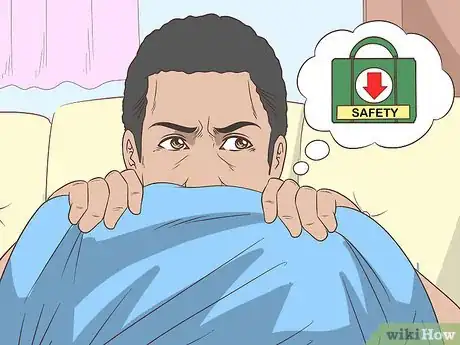This article was co-authored by Klare Heston, LCSW. Klare Heston is a Licensed Independent Clinical Social Worker based in Cleveland, Ohio. With experience in academic counseling and clinical supervision, Klare received her Master of Social Work from the Virginia Commonwealth University in 1983. She also holds a 2-Year Post-Graduate Certificate from the Gestalt Institute of Cleveland, as well as certification in Family Therapy, Supervision, Mediation, and Trauma Recovery and Treatment (EMDR).
wikiHow marks an article as reader-approved once it receives enough positive feedback. This article received 12 testimonials and 85% of readers who voted found it helpful, earning it our reader-approved status.
This article has been viewed 351,742 times.
The sound of thunder may send a chill down your spine, leaving you trembling and afraid. Fear of thunderstorms is fairly common. Some people just get slightly uncomfortable and others obsess about when the next storm is coming. No matter how severe your phobia is, you can cope with your fear of thunderstorms by seeking support from others, trying to address your fear, and finding ways to distract yourself.
Steps
Addressing Your Fear of Thunderstorms
-
1Come up with a storm plan. A properly installed lightning rod is the best protection for any building during a thunderstorm. Having a solid plan in place for severe storms can help alleviate your fears. Figure out the safest place in your home during a storm, away from windows. Basements, interior rooms, or rooms on the first floor are good for this.
- Figure out what you will do if you are outdoors or in a car during the storm. You can pull your car into a parking lot or onto the side of the road if it starts to storm. A car is usually safe to be in during a thunderstorm.
-
2Expose yourself to storms in a controlled situation. Facing your fear by exposing yourself to the thing you are afraid of can help you desensitize yourself. Consider listening to sound recordings of storms, making sure it includes heavy thunder. Do this occasionally during calm weather so you know that you are safe. Try doing this a few times a week to help decrease your fear.[1]
- You also can watch videos of storms. However, you should wait until the sounds of storms do not make you overly upset.
- Don't get frustrated if you don't get used to them immediately, or you see no change the next time there's a storm. It takes awhile to desensitize yourself to something you are afraid of.
Advertisement -
3Decrease the amount of safety items you use. People who are scared of storms often use items to help them feel more secure during storms. To try to break your reliance on these items and lessen your fear, use fewer protection items. This helps you become more comfortable dealing with the storm instead of clinging to safety items. Each time there is a storm, try to make one small change.
- For example, you can use smaller blankets, stay in the living room instead of hiding in your room, or leave the door open when you’re in the closet.
- Do this slowly because you won't be able to get rid of everything at once. If you need, have someone sit with you as you use fewer safety items.
-
4Limit how often you check the weather. You shouldn’t constantly check the weather forecast because you are afraid it is going to storm. This can lead to more anxiety instead of helping. Focus on handling the situation when a storm happens unexpectedly instead of obsessing over the forecast.
Seeking Support for Your Fear of Thunderstorms
-
1Talk to your family and friends. The people in your life can help give you support as you face your fear of thunderstorms. You can talk to them about your fear or turn to them to help you when a storm approaches.[2]
- If you decide to expose yourself to a storm, ask a family member or friend to be with you and help you through it.
-
2Call someone. When you are scared during a thunderstorm, call someone you trust. Talk to them to try to calm down. If you are feeling anxiety, you can focus on the conversation instead of the storm. Be aware the cellphone is no use if the power's out however.
-
3Talk to a therapist. If your fear of thunderstorms is so severe that you are always scared of the next thunderstorm, or it is interfering with your daily life, you should see a therapist. Fear of thunderstorms is a real phobia that can cause severe anxiety and lead to physical symptoms.
- Look for psychologists or therapists in your area that deal with phobias. Try calling their offices to find out if they can help with your fear of thunderstorms.
Dealing with Your Anxiety about Thunderstorms
-
1Repeat a calming phrase. A phrase or mantra can help you focus on something other than the fear. If you are feeling panicked, the mantra can pull you out of the panic and bring you back to the present. Focusing on the mantra can help you control your emotions so your anxiety doesn’t control you.[3]
- Make your mantra something happy and calming. For example, if you like dogs, make your mantra something like, “Cute puppies on the grass.”
-
2Do breathing exercises. Breathing exercises can help you reduce your panic and anxiety when it starts to overwhelm you. When you confront a storm, you can do breathing exercises to stay grounded and calm despite the thunder and lightning.[4]
- For example, you can breathe in for a count of five to seven, hold the breath for four counts, and then exhale for a count of five.
-
3Confront your negative thoughts. Fears arise from bad experiences and negative thoughts. To help get over your fear of thunderstorms, figure out what those thoughts are. Try writing down what you think about during a thunderstorms or what scares you so bad. Then, identify those thoughts as negative and false. When a storm approaches and you start thinking the negative thoughts, replace them with positive thoughts.[5]
- For example, you may think that the thunder is going to hurt you and that lightning is going to kill you. When you are in a storm, tell yourself, “These thoughts are negative and false. Thunder is just sound. It cannot hurt me. I am safe in my house. Lightning cannot get me right here.”
-
4Cuddle up with a favorite stuffed animal or blanket. Wrapping yourself in a blanking or holding a stuffed animal may help you feel better. Feeling the secure blanket tightly around you can calm your anxiety.[6]
-
5Distract yourself from the storm. Find ways to amuse yourself and distract yourself during a storm. This helps you take control of the situation, focus on something positive instead of your fear, and hopefully learn how to cope during storms.[7]
- Find a place where you feel comfortable to do something like reading a book, playing a board game, or watching TV.
-
6Listen to music. Playing calming or happy music can help relieve your anxiety and distract you from the storm. If the storm is too much, you can put on headphones that can block out the noise. Noise cancelling headphones may help.[8]
Gaining Knowledge
-
1Research on thunderstorms. Educating yourself can help you understand thunderstorms so they can lose some of their power over you. Look up statistics about lightning strikes accidents. The number of people getting struck by lightning is low, especially indoors. Lightning will always strike the nearest electrically conductible object in its vicinity, and if you're indoors, that is most definitely not you.[9]
- Learn what causes lightning and the sound of thunder, and learn about how lightning strikes occur.
-
2Be informed. Watching your local weather channel if bad weather is predicted can help prepare you for any incoming storms. Radars will show the projected path of the storm and will estimate the severity of the storm based on the colors on the radar.[10]
- Remember, storms may be slightly worse or less severe when they reach your area. Preparing yourself for the storm can help you face any storm that comes.
- Often, red and yellow areas on a radar just mean heavy rain and don’t necessarily mean terrible lightning and thunder.
-
3Learn the difference between watches and warnings. Weather bulletins will be issued for both thunderstorm watches and thunderstorm warnings. Watches mean the conditions are favorable and there may be a storm in the future. Warnings mean there are storms in your area that you need to be aware of and prepare for.[11]
Expert Q&A
Did you know you can get expert answers for this article?
Unlock expert answers by supporting wikiHow
-
QuestionWhat do you call the fear of thunderstorms?
 Klare Heston, LCSWKlare Heston is a Licensed Independent Clinical Social Worker based in Cleveland, Ohio. With experience in academic counseling and clinical supervision, Klare received her Master of Social Work from the Virginia Commonwealth University in 1983. She also holds a 2-Year Post-Graduate Certificate from the Gestalt Institute of Cleveland, as well as certification in Family Therapy, Supervision, Mediation, and Trauma Recovery and Treatment (EMDR).
Klare Heston, LCSWKlare Heston is a Licensed Independent Clinical Social Worker based in Cleveland, Ohio. With experience in academic counseling and clinical supervision, Klare received her Master of Social Work from the Virginia Commonwealth University in 1983. She also holds a 2-Year Post-Graduate Certificate from the Gestalt Institute of Cleveland, as well as certification in Family Therapy, Supervision, Mediation, and Trauma Recovery and Treatment (EMDR).
Licensed Social Worker
-
QuestionHow do you treat Astraphobia?
 Klare Heston, LCSWKlare Heston is a Licensed Independent Clinical Social Worker based in Cleveland, Ohio. With experience in academic counseling and clinical supervision, Klare received her Master of Social Work from the Virginia Commonwealth University in 1983. She also holds a 2-Year Post-Graduate Certificate from the Gestalt Institute of Cleveland, as well as certification in Family Therapy, Supervision, Mediation, and Trauma Recovery and Treatment (EMDR).
Klare Heston, LCSWKlare Heston is a Licensed Independent Clinical Social Worker based in Cleveland, Ohio. With experience in academic counseling and clinical supervision, Klare received her Master of Social Work from the Virginia Commonwealth University in 1983. She also holds a 2-Year Post-Graduate Certificate from the Gestalt Institute of Cleveland, as well as certification in Family Therapy, Supervision, Mediation, and Trauma Recovery and Treatment (EMDR).
Licensed Social Worker
-
QuestionIs it normal to be afraid of thunderstorms?
 Klare Heston, LCSWKlare Heston is a Licensed Independent Clinical Social Worker based in Cleveland, Ohio. With experience in academic counseling and clinical supervision, Klare received her Master of Social Work from the Virginia Commonwealth University in 1983. She also holds a 2-Year Post-Graduate Certificate from the Gestalt Institute of Cleveland, as well as certification in Family Therapy, Supervision, Mediation, and Trauma Recovery and Treatment (EMDR).
Klare Heston, LCSWKlare Heston is a Licensed Independent Clinical Social Worker based in Cleveland, Ohio. With experience in academic counseling and clinical supervision, Klare received her Master of Social Work from the Virginia Commonwealth University in 1983. She also holds a 2-Year Post-Graduate Certificate from the Gestalt Institute of Cleveland, as well as certification in Family Therapy, Supervision, Mediation, and Trauma Recovery and Treatment (EMDR).
Licensed Social Worker
References
- ↑ http://www.calmclinic.com/phobias/astraphobia
- ↑ https://www.adaa.org/living-with-anxiety/managing-anxiety/hurricane-season-here-how-reduce-your-anxiety
- ↑ http://www.calmclinic.com/phobias/astraphobia
- ↑ http://www.calmclinic.com/phobias/astraphobia
- ↑ http://www.calmclinic.com/phobias/astraphobia
- ↑ http://earthsky.org/earth/scared-of-thunder-and-lightning-you-have-astraphobia
- ↑ http://kidshealth.org/en/kids/thunderstorms.html#
- ↑ http://kidshealth.org/en/kids/thunderstorms.html#
- ↑ http://www.registerednursern.com/lilapsophobia-overcome-your-fear-of-tornadoes-severe-storms-and-hurricanes/
About This Article
To face your fear of thunderstorms, try exposing yourself to storms in controlled settings, like listening to audio recordings of thunder, to help desensitize you to them. Once you’re comfortable with that, try watching videos of thunderstorms a few times a week. You can also use deep breathing exercises during thunderstorms to help reduce your panic and anxiety. For example, try breathing in for 5 seconds, holding it for 4 seconds, then exhaling for 5 seconds. For more advice, like how to face your fear by confronting negative thoughts and experiences, keep reading!















































































Medical Disclaimer
The content of this article is not intended to be a substitute for professional medical advice, examination, diagnosis, or treatment. You should always contact your doctor or other qualified healthcare professional before starting, changing, or stopping any kind of health treatment.
Read More...